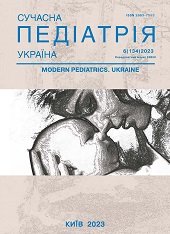State of the tolerance to physical activity and characteristics of myocardial reserves in children after COVID-19
DOI:
https://doi.org/10.15574/SP.2023.134.91Keywords:
coronavirus disease, COVID-19, coronavirus infection, SARS-CoV-2, exercise tolerance, bicycle ergometry, myocardial reserves, childrenAbstract
Assessment of the state of exercise tolerance (ET) after the transfer of COVID-19 is necessary to determine the long-term consequences of the coronavirus disease.
Purpose - to assess the state of ET and analyze changes in myocardial reserve indicators in children who have experienced COVID-19 of varying degrees of severity.
Materials and methods. 155 school-age children took part in the study. 120 children with a confirmed diagnosis of COVID-19 in the anamnesis and a period after COVID-19 of more than 12 weeks (main group) and 35 healthy children who did not suffer from COVID-19 (control group). The Group I (n=49) included children who contracted mild COVID-19; the Group II (n=40) - children who suffered from COVID-19 of moderate severity, the Group III (n=31) - children who contracted COVID-19 with a severe course. General clinical, instrumental (cycle ergometry), and statistical research methods were used.
Results. In the main group, the average value of maximum oxygen consumption (VO2max) was 26.86±6.69 ml/kg/min, and in the control group - 38.29±5.54 ml/kg/min (p<0.001). The analysis of this indicator in the Groups I, II, and III showed that transferred COVID-19 affects the level of ET in boys regardless of the severity of COVID-19 (p<0.01). In girls, reduced ET was determined in the case of moderate and severe course of COVID-19. The analysis of myocardial reserves indicators showed that among children who fell ill with COVID-19, the worst indicators were observed in the Groups II and III (p<0.01).
Conclusions. Transmitted COVID-19 affects the state of ET and indicators of myocardial reserves in children in the period more than 12 weeks after COVID-19. The level of changes in the state of ET, values of the cardiac and vascular component of physical load support, and myocardial reserves depend on the degree of severity of the transferred COVID-19, which is confirmed by correlations of varying strength between these indicators and the degree of severity of COVID-19.
The research was carried out in accordance with the principles of the Helsinki Declaration. The study protocol was approved by the Local Ethics Committee of the participating institution. The informed consent of the patient was obtained for conducting the studies.
No conflict of interests was declared by the authors.
References
American Academy of Pediatrics. (2022). Post-COVID-19 conditions in children and adolescents. URL: https://www.aap.org/en/pages/2019-novel-coronavirus-covid-19-infections/clinical-guidance/post-covid-19-conditions-in-children-and-adolescents/.
Baechle TR, Earle RW (Eds.). (2008). Essentials of strength training and conditioning. Human kinetics: 641.
Buonsenso D, Gennaro LD, Rose CD, Morello R, D'Ilario F, Zampino G et al. (2022). Long-term outcomes of pediatric infections: from traditional infectious diseases to long Covid. Future microbiology. 17 (7): 551-571. https://doi.org/10.2217/fmb-2022-0031; PMid:35264003 PMCid:PMC8910780
Buttar KK, Saboo N, Kacker S. (2019). A review: Maximal oxygen uptake (VO2 max) and its estimation methods. IJPESH. 6: 24-32.
Dayton JD, Ford K, Carroll SJ, Flynn PA, Kourtidou S, Holzer RJ. (2021). The deconditioning effect of the COVID-19 pandemic on unaffected healthy children. Pediatric cardiology. 42 (3): 554-559. https://doi.org/10.1007/s00246-020-02513-w; PMid:33394120 PMCid:PMC7780912
Hyshchak TV, Marushko YuV, Dmytryshyn OA, Kostynska NG, Dmytryshyn BYa. (2022). Tolerance to physical activity and its changes in children after COVID-19 (literature review, own data). Modern Pediatrics. Ukraine. 5 (125): 108-116. https://doi.org/10.15574/SP.2022.125.108
Kanda Y. (2013). Investigation of the freely available easy-to-use software 'EZR' for medical statistics. Bone Marrow Transplant. 48: 452-458. https://doi.org/10.1038/bmt.2012.244; PMid:23208313 PMCid:PMC3590441
López-Bueno R, Calatayud J, Andersen LL, Casaña J, Ezzatvar Y, Casajús JA et al. (2021). Cardiorespiratory fitness in adolescents before and after the COVID-19 confinement: a prospective cohort study. European journal of pediatrics. 180 (7): 2287-2293. https://doi.org/10.1007/s00431-021-04029-8; PMid:33733288 PMCid:PMC7968551
Marushko Y, Dmytryshyn O, Hyshchak T, Iovitsa T, Bovkun O. (2023). Peculiarities of the methodology, diagnostic value, and global recommendations for assessing exercise tolerance in children (literature review, own research). Child's health. 17 (8): 401-410. https://doi.org/10.22141/2224-0551.17.8.2022.1547
Marushko YuV, Dmytryshyn OA. (2023). Evaluation of the effectiveness of the magnesium-potassium complex in correcting the health status of children who have suffered from COVID-19. Modern Pediatrics. Ukraine. 4 (132): 7-15. https://doi.org/10.15574/SP.2023.132.7
Marushko YuV, Hyshchak TV, Kostynska NG, Dmytryshyn OA. (2023). Determination of tolerance to physical exertion body reserves in school-age children with obesity and arterial hypertension. Modern Pediatrics. Ukraine. 3 (131): 37-45. https://doi.org/10.15574/SP.2023.131.37
Marushko YuV, Hyshchak TV. (2014). Systemni mekhanizmy adaptatsii. Stres u ditei. Monohrafiia. Kyiv: 138.
Marushko YuV, Hyshchak TV. (2017). Osoblyvosti funktsionalnykh rezerviv sertsevo-sudynnoi systemy za rezultatamy veloerhometrii u ditei z pervynnoiu arterialnoiu hipertenziieiu i defitsytom mahniiu ta vyiavlenykh porushen. Sovremennaia pedyatryia. 1 (81): 92-98.
MOZ Ukrainy. (2020). Pro zatverdzhennia protokolu "Nadannia medychnoi dopomohy dlia likuvannia koronavirusnoi khvoroby (COVID-19)". Ofitsiinyi vebportal parlamentu Ukrainy. URL: https://zakon.rada.gov.ua/rada/show/v0762282-20#Text.
Senatorova HS, Honchar MA, Sanina IO, Onikiienko OL, Strashok OI. (2014). Funktsionalni proby sertsevo-sudynnoi systemy v dytiachii kardiolohii. Kharkiv: KhNMU: 32.
Shevchenko N, Holovko T, Aghogho A, Margret M, Bernard OF. (2021). Riven tolerantnosti do fizychnoho navantazhennia u zdorovykh pidlitkiv. Aktualni problemy suchasnoi medytsyny: 7.
Downloads
Published
Issue
Section
License
Copyright (c) 2023 Modern pediatrics. Ukraine

This work is licensed under a Creative Commons Attribution-NonCommercial 4.0 International License.
The policy of the Journal “MODERN PEDIATRICS. UKRAINE” is compatible with the vast majority of funders' of open access and self-archiving policies. The journal provides immediate open access route being convinced that everyone – not only scientists - can benefit from research results, and publishes articles exclusively under open access distribution, with a Creative Commons Attribution-Noncommercial 4.0 international license (СС BY-NC).
Authors transfer the copyright to the Journal “MODERN PEDIATRICS. UKRAINE” when the manuscript is accepted for publication. Authors declare that this manuscript has not been published nor is under simultaneous consideration for publication elsewhere. After publication, the articles become freely available on-line to the public.
Readers have the right to use, distribute, and reproduce articles in any medium, provided the articles and the journal are properly cited.
The use of published materials for commercial purposes is strongly prohibited.

